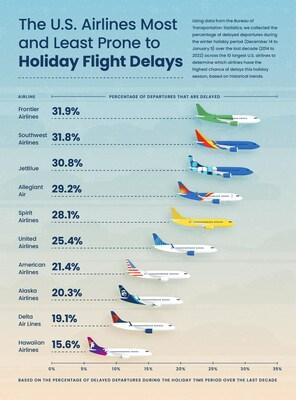Rising Flight Delays Disrupt U.S. Airports Amid Operational Strains
How Flight Delays Affect Travelers and Airline Operations
Across prominent U.S. airports, the surge in flight delays is causing significant disruptions for passengers and airlines alike. Travelers are increasingly encountering missed connections, altered itineraries, and heightened stress levels, especially business commuters and those with tight schedules. Beyond passenger inconvenience, airlines face a domino effect of operational hurdles, including:
- Congested aircraft turnaround processes that create scheduling bottlenecks.
- Intensified pressure on staff to handle rebooking and customer support efficiently.
- Escalating operational expenses due to inefficient fuel use and extended crew hours.
- Overburdened airport infrastructure such as limited gate availability and runway congestion.
These interconnected challenges underscore the fragile balance within the aviation network, where delays at one airport can cascade nationwide. To combat this, airlines and airports are increasingly leveraging predictive analytics and real-time data sharing to enhance disruption management and passenger communication. Nevertheless, until systemic issues like congestion and workforce shortages are resolved, delays are expected to remain a persistent challenge throughout peak travel periods.
| Airport | Average Delay (minutes) | Severity |
|---|---|---|
| John F. Kennedy (JFK) | 44 | Severe |
| Chicago O’Hare (ORD) | 40 | Severe |
| Atlanta Hartsfield-Jackson (ATL) | 31 | Moderate |
| Denver International (DEN) | 26 | Moderate |
| San Francisco International (SFO) | 22 | Low |
Air Traffic Control Struggles Amid Growing Flight Volumes
Air traffic controllers at the busiest U.S. airports are facing unprecedented pressure as flight volumes surge beyond the capacity of existing infrastructure and personnel. Major hubs such as AtlantaŌĆÖs Hartsfield-Jackson and Chicago OŌĆÖHare are particularly strained, with aging radar and communication systems unable to keep up with the rapid pace of flight operations. This overload not only causes delays but also challenges the safety margins that controllers must uphold.
Key contributors to these difficulties include:
- Rising air traffic without parallel upgrades to control technology
- Workforce shortages driven by retirements and pandemic-related absences
- Unpredictable weather patterns complicating flight routing and sequencing
- Interference from simultaneous military airspace activities
| Airport Hub | Daily Flight Count | Average Delay (minutes) |
|---|---|---|
| Hartsfield-Jackson ATL | 2,600 | 47 |
| Chicago O’Hare ORD | 2,000 | 41 |
| Los Angeles LAX | 1,700 | 35 |
| Dallas/Fort Worth DFW | 1,450 | 31 |
Weather Conditions and Workforce Gaps Amplify Scheduling Issues
Recent severe weather events, including intense cold snaps and heavy snowstorms across the Midwest and Northeast, have further complicated airport operations. These conditions necessitate extended aircraft safety checks and de-icing procedures, leading to longer turnaround times. Additionally, strong winds and snowfall hinder ground operations, causing tarmac congestion and delays in departures and arrivals.
At the same time, persistent staffing shortages continue to disrupt flight schedules amid rising passenger demand. Airlines are struggling to fill critical roles such as pilots, air traffic controllers, and ground personnel, resulting in frequent last-minute schedule changes. Factors contributing to these shortages include:
- COVID-19 related absences and quarantine protocols
- High burnout rates and increased employee turnover
- Delays in training and certification for new hires
| Airport | Average Delay (minutes) | Staff Absences (Past Week) |
|---|---|---|
| Chicago O’Hare | 60 | 90 |
| Newark Liberty | 50 | 70 |
| Denver International | 55 | 52 |
Innovative Solutions to Reduce Delays and Boost Airport Efficiency
In response to escalating delays, airports nationwide are investing heavily in advanced technologies and operational improvements. A leading strategy involves deploying real-time data analytics to track air traffic and weather conditions, allowing for dynamic scheduling and gate management. Furthermore, many airports are enhancing staff training and optimizing resource deployment during peak travel times to alleviate congestion and improve passenger flow.
Additional measures being implemented include:
- Upgraded communication networks linking airlines, air traffic control, and ground teams for quicker coordination.
- Automated check-in and baggage handling systems to speed up processing and reduce errors.
- Dynamic runway and taxiway management to maximize throughput and minimize idle time.
| Initiative | Advantage | Current Status |
|---|---|---|
| Real-Time Data Analytics | Enhanced scheduling precision | In Progress |
| Automated Baggage Handling | Reduced wait times | Partially Implemented |
| Cross-Training Staff | Greater operational adaptability | Expanded |
| Communication System Upgrades | Faster decision-making | Initiated |
Final Thoughts
As flight delays continue to affect major U.S. airports, travelers should remain vigilant and plan for potential disruptions. While airlines and airport authorities are actively addressing root causes, including infrastructure and staffing challenges, passengers should monitor flight updates closely and allow extra time for connections. Navigating this period of operational strain requires flexibility and preparedness from all stakeholders in the air travel ecosystem.







